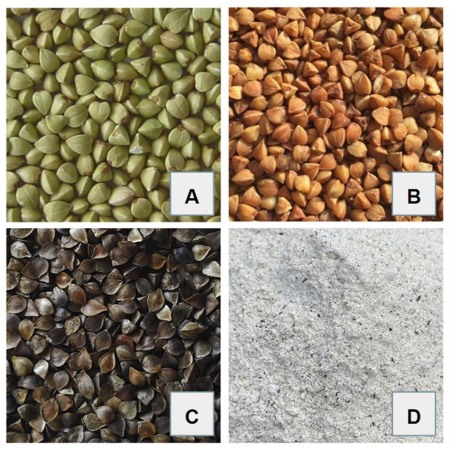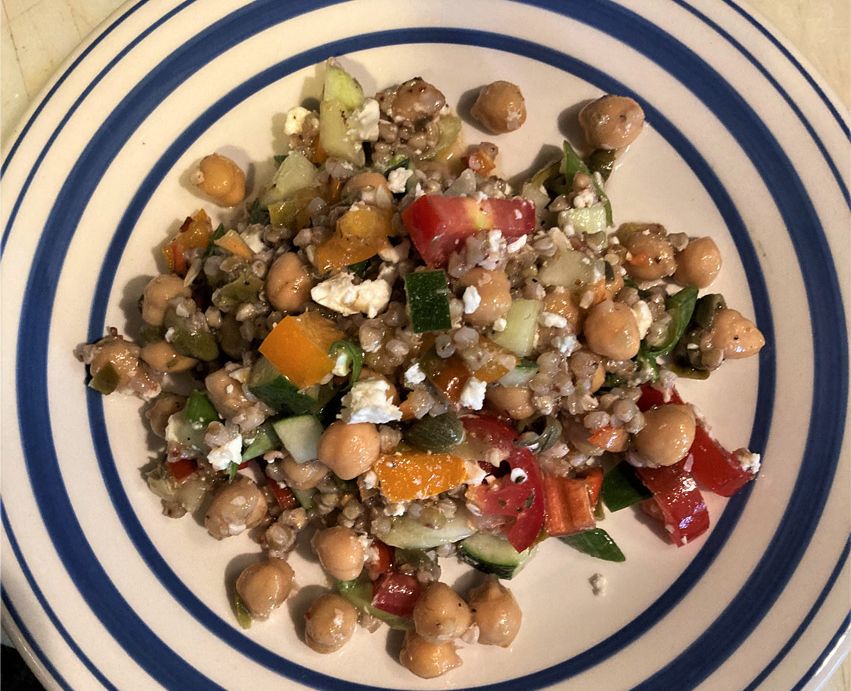
Fall is here! I can smell the hot apple cider, hear the crisp bites of apples harvested from local orchards, and taste the earthy, nutty flavor of buckwheat pancakes. Buckwheat is one of my favorite plant-based foods to use in baked goods, hot and cold dishes, and even tea. Not only does it taste delicious; it also plays an essential role in a regenerative/organic farming system—and it’s good for you.
What is Regenerative Agriculture?
At Basil’s Harvest, we collaborate with food and farming professionals to investigate and develop new pathways for regional, regenerative foods to enter the market. We are currently working with Cow Creek Organics and Janie’s Farm in east-central Illinois, for example, to serve small grains at OSF HealthCare Saint Francis Medical Center.
I am sure you’re familiar with words like “organic” and “sustainable,” but what does regenerative mean? Regenerative agriculture works with nature by promoting practices that bring back biodiversity and habitats to create living ecosystems on top of the soil and beneath it in order to improve our living soil and reverse climate change. We look at health in the same way: preventing disease through a regenerative, organic, plant-based, whole-food diet that starts on farms that work in harmony with nature.
Buckwheat is a seed that is beneficial to both our environment and our bodies. It is considered an ancient grain, domesticated more than 8,000 years ago in southeast Asia. This fast-growing plant has been recently rediscovered as a beneficial cover crop, as it supports ecosystems and promotes farm resiliency. Regenerative/organic farms like Cow Creek Organic and Janie’s Farm utilize buckwheat (or are experimenting with it) as part of their crop rotation to increase diversity, promote pollinators as part of the farm ecosystem, and support soil health in a regenerative/organic ecosystem. Honey bees utilize buckwheat as a nectar source that will produce dark, molasses-like honey.
Exploring Taste and Texture
When harvested, buckwheat “groats” are used in recipes and provide a wonderfully toasty, nutty flavor and soft, chewy texture. Groats are the gluten-free seeds within the flowering buckwheat plant which typically appear in soba noodles, buckwheat flour, and roasted groats or kasha. Groats are commonly eaten as porridge in western Asia and Eastern Europe, but are equally delicious in salads and risotto. Despite the name, buckwheat is not related to wheat and can be a gluten-free alternative to use in cooking.
To explore the taste and texture of the groats, I recommend trying this nourishing Mediterranean buckwheat salad. Most natural grocery stores, food co-ops, international stores and grocery stores stock buckwheat flour and groats. To support your regional food system, buy local and get your buckwheat flour from Janie’s Mill in east-central Illinois!
Erin Meyer, MSFS, Chef/RD, is executive director and Kelly Bloedorn, MSFS, is communications and management associate at Basil’s Harvest. To learn more about the organization and its work, find them on social media @basilsharvest.
Mediterranean Buckwheat Salad
Serves 8
Recipe by Erin Meyer, MSFS, Chef/RD and Golda Ewalt, MS, Chef/RD
Ingredients
½ cup buckwheat groats
1¼ cup water
¼ teaspoon salt
1 can garbanzo beans, drained
¼ - ½ teaspoon salt
¼ teaspoon pepper
½ cup green onion
1 cup cherry, grape or diced tomatoes (multi-colored, if possible)
1 cup cucumber, chopped
⅓ cup capers, chopped (kalamata olives may be substituted)
1 colored pepper, seeded and chopped
½ cup chopped parsley
⅓ cup extra virgin olive oil
2 Tablespoons lemon juice (1 small lemon)
1 Tablespoon caper juice
¼ teaspoon chili garlic sauce (more to taste)
Pinch of salt
Pinch of pepper
1 teaspoon dried oregano or 1 Tablespoon fresh oregano
½ cup crumbled feta cheese (optional)
Directions
- Rinse buckwheat 2-3 times to remove flour or small buckwheat pieces. Combine buckwheat, water and salt in a small saucepan and bring to a boil.
- Cover, turn heat to low and simmer for 6-8 minutes. Buckwheat tends to cook quickly. Read directions, but test for doneness halfway through cooking time. Watch carefully.
- Remove from heat, drain excess water and let stand uncovered for 5 minutes. Fluff with a fork and let cool.
- In a medium-sized bowl, combine buckwheat groats, beans, salt, pepper, capers, chopped parsley and fresh vegetables.
- To make the dressing, combine lemon juice, caper juice, chili garlic sauce, salt, pepper and oregano in a small bowl. Gently whisk oil until combined. Taste and adjust seasonings.
- Gently combine half of the dressing with salad. Taste and adjust seasoning. Add more dressing if needed. Combine. Top with feta cheese and serve. PM
- Log in to post comments

